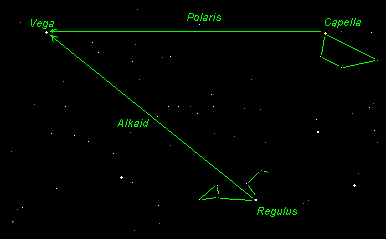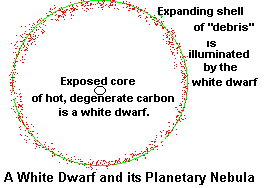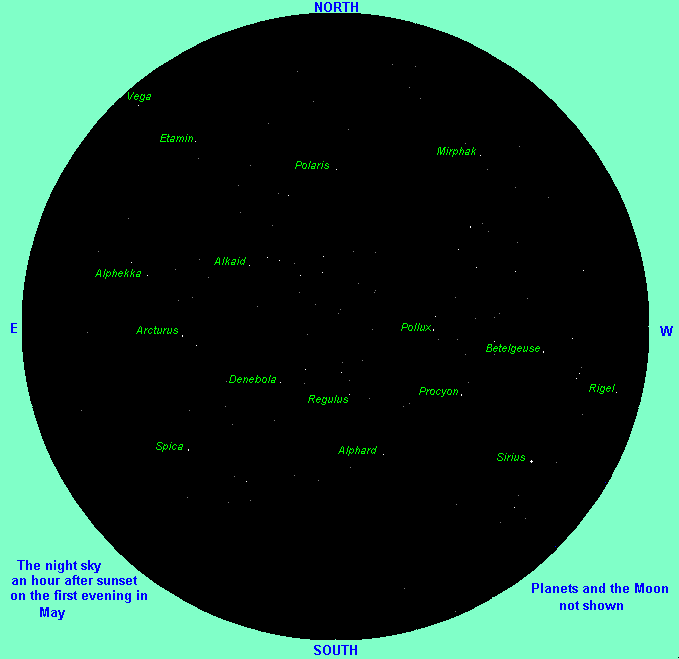We have a meteor shower this month but, before we get to that, let's talk a little about the stars and I will show you where a dead star is buried.
May is a great month to enjoy the night sky because the weather
is so much better. Summer is on the way!  Soon after sunset we
see a sky that is moving into its "summer phase". If you stay outside a few hours past sunset you will get a preview of our summer stars and constellations.
Soon after sunset we
see a sky that is moving into its "summer phase". If you stay outside a few hours past sunset you will get a preview of our summer stars and constellations.
Rising from the eastern horizon, about an hour after sunset (so it's barely seen on our monthly map below) is the brilliant star Vega. This is the first star of the "Summer Triangle" and I like to think of it as the first star of summer. The Summer Triangle isn't a constellation - it's a pattern of three bright stars each from a different constellation. You'll have to wait another hour or two to see the other stars that make up the rest of the Summer Triangle but Vega, with a magnitude zero (0.0), is a real treat on its very own. It's 50 times more luminous as the Sun and only 26 light-years away so it's very bright in our night sky.
|
There are two ways to find Vega.
Using the northern sky, draw a line from Capella (the bright yellowish star in the constellation of Auriga) towards Polaris, but continue over to the other side of the sky. The first bright star you come to is Vega. If clouds block your view of Capella, you can find Vega by the "southern route". Imagine a line from Regulus (in Leo) to the last star in the Big Dipper's handle (Alkaid), then continue on for a similar distance and you will find Vega. | 
|
It's the brightest star of the constellation of Lyra, the Harp.
| Lyra is a pretty small constellation so I've included the Big Dipper in this image to give you an idea of the scale and the neighborhood. Vega is in the spike on the top of the harp and the harp itself is made of four stars that form a nice diamond shape. | 
|
In 1983 the Infra-Red Astronomical Satellite detected a cloud
of cool (infrared) material orbiting Vega. This was interpreted
as a disk of sub-planetary size materials, like asteroids and comets,
orbiting the star. We believe that our Solar System started in this
way - as a disk of condensing materials that eventually accumulated
by gravity into planets. In the early 1990s ground-based instruments
mapped the shape of the materials surrounding Vega (and two other
stars, Fomalhaut and Beta Pictoris) and showed that the materials
are not distributed evenly. There are localized concentrations
of materials in some places and gaps in other parts of the disk.
Some astronomers interpret this as evidence of "planet formation"
claiming that planets around Vega are producing the localized
concentrations of materials in the disk. It's possible that,
at this very moment, planets are being created around Vega. 
Opposite Vega but still in Lyra is the Ring Nebula. (Also called "M57".) The story of the Ring Nebula is the opposite of Vega's. Not so long ago an old star used to sit in this part of Lyra. As that old star ran out of nuclear fuel it underwent a series of convulsion and eventually threw off its outer layers in a violent explosion! The "ring" is actually a sphere of material ejected from the dying star. Its ring appearance is just a line-of-sight effect. When nebula like these were first discovered, hundreds of years ago, it was thought that the ring was due to condensing, not expanding, of materials - like what is (probably) going on around Vega. That's how planets form, so early astronomers erroneously named these ring-shaped nebula, "planetary nebula". Nothing could be further from the truth. A planetary nebula, like the Ring Nebula in Lyra, is NOT the sign of planet formation. It's the sign of a recently dead star. Indeed, any planets that orbited that star were probably blown to bits!
| The "corpse star" left behind, in the center of the explosion, is a white dwarf. These stars are VERY dense. A teaspoon of white dwarf material weighs a ton - literally! (That's about a thousand kilograms per cubic centimeter.) It's impossible to squeeze atoms that tightly without destroying their atomic structure. Every atom in the white dwarf is transformed into an unusual state of matter called degenerate matter - a tight mass of nuclei and electrons with no real atomic structure. There's nothing on Earth like it! Both the white dwarf and the nebula around it are very dim when compared to other stars like Vega. | 
|
The light given off by a white dwarf is the remnant energy (heat) leftover from its former life as a "proper" nuclear-fusing star. White dwarfs live off the leftover energy. (They no longer undergo nuclear fusion.) The dwarf in the center heats the nebular materials and makes them glow, so the planetary nebula is illuminated by re-emitted light. As the centuries go by this planetary nebula will move farther away from this dwarf and eventually disappear.
The Ring Nebula has a magnitude of 9.7 so it's too dim for most binoculars but within the range of a good telescope.
| It's a great "find" for amateur astronomers so, if you have a telescope, give it a try. The two brightest stars in the diamond, Sulaphat and Sheliak, are on the side of the harp opposite Vega. The Ring Nebula is positioned between them. It will look like a dim smoke ring in an amateur telescope. | 
|
As May progresses and summer arrives, Vega will be found higher
and higher in the northern sky after sunset so it will become easier to
view. Have a look at Vega and imagine that a whole new solar system
is being created around it. Then look to the south of Vega, along
the edge of the Harp. Even if you don't have a telescope, it's
interesting to think that here lies a "stellar disaster".
One day, in about 5 billions years, the Sun will
grow old, die and explode. When it does so it will throw off its
outer layers to create a "planetary nebula" like the
Ring Nebula and it the process it will destroy the Earth. Look
towards the Ring Nebula and remind yourself that we've only got
about 5 billion years left - so you better enjoy this summer!
On the other hand, in a few million years there should be some
interesting real estate orbiting Vega and it's only 26 light-years
away so we've got plenty of time to get there! 
Speaking of debris ...
On May 5th the Earth passes through the center of a debris trail left by good ol' comet Halley!  This comet has an orbital period of about 76 years. (I say "about" because, like most comets, Halley is tugged around a bit by the planets' gravitational pull and that affects its timing a little.) The comet passed along this route in 1986 and as it moved along it left a trail of debris. With each orbit it leaves behind a little reminder of its visit and each year we cross into that reminder. As bits of Halley strike the Earth we experience a meteor shower! We start sliding into the path as early as the last week of April and continue to be pelted by chunks of Halley until about the third week of May. These showers are called the Eta Aquarids because the meteors appear to come from that part of the constellation of Aquarius. (Late in October we pass through another section of Halley's debris path in a shower called the Orionids.) At their peak, May 5th, the Eta Aquarids may produce up to 30 meteors per hour
This comet has an orbital period of about 76 years. (I say "about" because, like most comets, Halley is tugged around a bit by the planets' gravitational pull and that affects its timing a little.) The comet passed along this route in 1986 and as it moved along it left a trail of debris. With each orbit it leaves behind a little reminder of its visit and each year we cross into that reminder. As bits of Halley strike the Earth we experience a meteor shower! We start sliding into the path as early as the last week of April and continue to be pelted by chunks of Halley until about the third week of May. These showers are called the Eta Aquarids because the meteors appear to come from that part of the constellation of Aquarius. (Late in October we pass through another section of Halley's debris path in a shower called the Orionids.) At their peak, May 5th, the Eta Aquarids may produce up to 30 meteors per hour
|
Your sky map for the month of May
Here's a map of the clear, night sky as seen from the center of the USA on the first evening of this month, an hour after sunset. Specifically, this is the view of a clear sky from a latitude of 37N. Star-gazers farther north, such as in Minneapolis, Chicago and most of Europe, will have more of the northern sky visible and the southern sky will be obscured by the horizon. Vice versa for those who are farther south. The stars will not change position relative to each other, however, throughout the month, the Moon and planets will wander, so they are not shown. Only objects of magnitude 4.0 and brighter are displayed. Here's a reverse color image of the map that will be easier on your printer. |  |
On the first night of May, 1949 Gerard Kuiper discovered Nereid, Neptune's second largest Moon. (Until Neptune was visited by the Voyager spacecraft, everyone thought that it had only two moons!) Subsequent observations of Nereid showed it had a highly eccentric orbit - its distance from Neptune varies from 1.3 to 9.7 billion kilometers. Perhaps it's a captured comet.
On May 28, 1959 Able and Baker complete a suborbital flight to become the first primates, Macca mulatta, in space.
Alan Shepard became the first American in space on May 5, 1961. His 15 minute suborbital flight in the Mercury spacecraft Freedom 7 put him in second place to the Russian Yuri Gagarin, who had actually orbited the Earth (one orbit) three weeks earlier. Regardless, Shepard's flight made the space race a two man (two nation) race!
Sixteen days later, on May 21st, President John F. Kennedy, speaking before a joint session of Congress upped the ante by declaring, "I believe this nation should commit itself to achieving the goal, before this decade is out, of landing a man on the moon and returning him safely to the Earth." With that sentence President Kennedy launched the most ambitious and far reaching science and engineering program the world has ever seen.
I hope you found the Night Sky this Month to be helpful and educational. I invite you to return here monthly for new information.